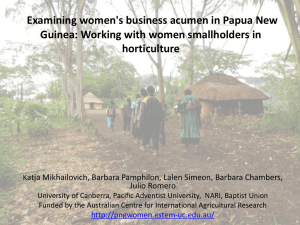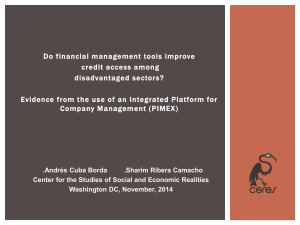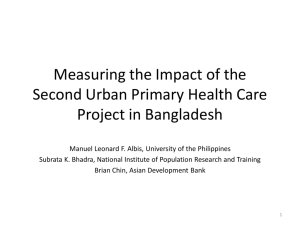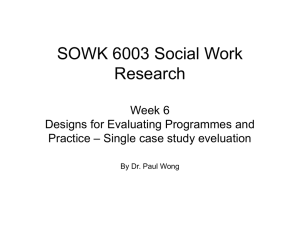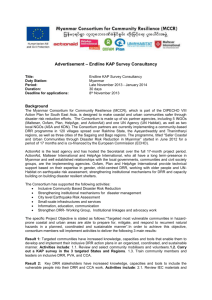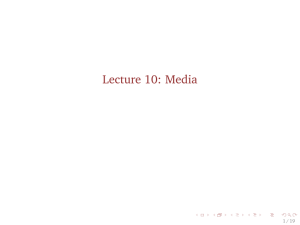Deepa_Sankar
advertisement
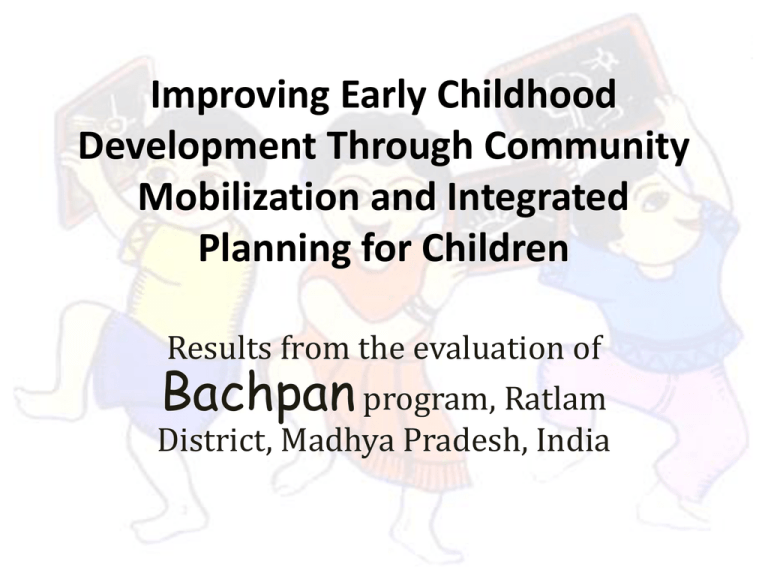
Improving Early Childhood Development Through Community Mobilization and Integrated Planning for Children Results from the evaluation of Bachpan program, Ratlam District, Madhya Pradesh, India Background…. • Starting point World Bank 2004 report “Reaching Out to the Child” • One of the recommendations: Village Plans for Child Development: – Decentralized, but led by an informed/ enlightened community; – Contextual and Cross-sectoral planning for children that would inform sectoral interventions and implementation. • Government of MP invited the World Bank to help the State in piloting the concept in a block in the State • Bank Response: – Support for Pilot, impact evaluation – Four partners: Naandi (NGO which implemented the concept pilot); INDICUS (baseline and end line surveys for IE); ERU (Process Documentation); Govt of MP (Programs and functionaries) Vision, Mission, and features of Project “Bachpan” • Vision: “Happy, Healthy and Learning Child” • Mission: Facilitate integrated child development by – helping improved service delivery through coordinated and convergent approach (addressing supply side); and – promoting better child care and development practices by educating community and providing information about child care practices, outcomes and availability of services and schemes. (demand side) • Key Features: • Address the life cycle continuum. • Establish convergence of provisions for children across health, nutrition and education • Engender bottom-up planning through community participation. • 4 Stages of Early childhood – – – – New born till 12 years, including the details from pre-natal care 12+ months to 24 months 24+ months to 6 years 6- 10 years Vision, Mission, and Objectives of Project “Bachpan” • Objectives: – Create awareness on child development with a focus on the girl child – Strengthen linkages between different service providers – Strengthen linkages between the community, panchayat and service Providers – Facilitate formation of Ekta Samuhs (Village Resource Groups) with representatives of the community, panchayat and service providers – Develop integrated village level action plans around the needs of the child – Advocate and lobby with local, district and state administration for flexible allocation of resources Interventions of Project “Bachpan” – Participatory resource/service delivery mapping. – Provision of information and educating the community on child development issues, as well as managing service delivery. – Community mobilization aimed at bringing parents and service providers on common platforms to discuss child development and service delivery issues. – Formation of Village Resource Groups (VRGs) called Ekta Samuhs (unity groups), to discuss child advancement issues, identify gaps and requirements, and formalize it in the form of village plans. – Facilitation of the interactions between VRGs and bock- and district-level health, nutrition and education officials, and feeding the village plans into district plans for RCH, ICDS and SSA. – Enable specific service provisions like the fixed day health check up (a particular day in a month agreed between the health worker and the community on which the health worker visits school and the community brings the children for regular check up) – Provide training to frontline service providers (health workers, anganwadi workers, and teachers) to manage service delivery records, effective service delivery, and sensitize them to ensure enhanced accountability. Key Milestones Sub-Stage 1: Improved monitoring of growth and development of children and health of pregnant women Sub-Stage 2: Improved rates of immunization by end of year 1; completion of all prophylaxis of Vitamin A; average daily time spent on adult-child interaction in families Sub-Stages 3/4 Quality of early childhood education; teacher and student attendance; rates of dropouts and transition; achievement levels in Grade 2 Percentage of pregnant women who received full antenatal check-up Percentage of pregnant women who regularly received supplementary food Percentage of deliveries assisted by the institutionally trained Percentage of children not underweight Percentage of mothers of children under one year who have provided six months exclusive breast-feeding Percentage of children fully immunized by year 1 Percentage of children who have completed all prophylaxis of Vitamin A Percentage of children with appropriate weight-for-age Average daily time spend on adult-child interaction in the family Percentage of children entering Grade 1 who have an adequate vocabulary in the school language Percentage of Grade I children who have attended preschool program Percentage of teacher and student attendance Rate of dropout and transition to next stage Achievement levels in language and Mathematics in Grade 2 Percentage of 6-11 year olds completing primary education Monitoring and Impact Evaluation • Pilot programs were implemented in Bajna, while a similar, neighboring tribal block Sailana was selected as the control block. • Baseline survey carried out in 2005-06; end-line survey in 2009 • Three modes of monitoring and e approach: – Regular monitoring by NGO, Government functionaries – Baseline and Endline surveys –by INDICUS – Process Documentation – quarterly visits, consultation with communities, recording all enabling factors and bottlenecks – Education Resource Unit (ERU) – Film – documenting the whole process of community mobilization and development of village plans for children Overall Results • The evaluation shows improvements in – community’s knowledge, awareness levels, and practices, – on most of the outcomes/sub-stage development milestones • between base line survey and end line survey period • But improvements in project area significantly better compared to the control area Intake of Iron Folic Acid (IFA) by pregnant women Proportion of Institutional delivery 80% 100% 70% 90% 60% 80% 50% 70% 60% 40% 50% 30% 40% 20% 30% 20% 10% 10% 0% 0% Bajna Baseline Survey Bajna Sailana Endline survey New born child's height and weight measured at birth Baseline Survey Sailana Endline survey Full Immunization by age 2 yrs 90% 80% 90% 80% 70% 60% 50% 40% 30% 20% 10% 0% 70% 60% 50% 40% 30% 20% 10% 0% Bajna Bajna Baseline Survey Sailana Sailana Endline survey Baseline Survey Endline survey IFA supplement to children 2-5 yrs Pre-school children appear clean and neat 80% 100% 70% 90% 80% 60% 70% 50% 60% 40% 50% 30% 40% 20% 30% 20% 10% 10% 0% 0% Bajna Baseline Survey Sailana Bajna Endline survey Baseline Survey School readiness scores Sailana Endline survey Grade 2 Mean scores 80% 80% 70% 70% 60% 60% 50% 50% 40% 40% 30% 30% 20% 20% 10% 0% 10% Bajna Sailana 0% Bajna Baseline Survey Sailana Endline survey Baseline Survey Endline survey Inferences • Coordinated cross-sectoral approach in planning and implementation produce better results than when delivered in silos? • Social sector outcomes are a result of a bouquet of interventions, identified in a contextual manner through participatory planning, rather than a top-down approach • Process documentation is important • Social sector interventions – critical minimum gestation period for impact Limitations • No process documentation in control area. Hence difficult to explain the improvements in control area; Since both blocks were adjacent, the “spill over” effects possible in control area • In a typical experimental design, service delivery in the control group is expected to remain same. However, there were changes in government officials, interventions etc .. In the absence of process documentation, difficult to capture whether these changes were similar or different in both blocks • The project / study groups were more or less homogenous.. (tribal area, mostly illiterate; social, economic and occupational profiles). Hence difficult to explain differential impact due to variations in socio-economic and household factors
